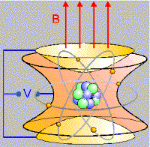

Low Energy Antiproton Ring: overview of the experimental area.

Schematic of an antiproton "trap"

Schematic of the antihydrogen experiment setup
The Accelerator Era
Low
energy frontier
With the discovery of the cooling
technique, available antimatter became a very important tool in particle
physics. Dedicated machines were built to handle the different stages
of antimatter production, accumulation and acceleration. Since the early
days though, they were mainly used to fill the specific needs of high-energy
experiments: beams of increasing energy were the goal of most laboratories.
But there are a lot of interesting things one can do with low energy antiprotons, and low energy (low speed) is definitely the only way to directly test the presumed symmetry between matter and antimatter. Slow antiprotons can be captured in real "traps", and their properties (mass, behavior in a magnetic field,etc.) compared to those of protons. One can make full pieces of antimatter, antiatoms made out of positrons and antiprotons.
CERN was the only laboratory which chose to specifically invest on this research line. In 1980 it decided to build a new machine, able to "decelerate" the antiprotons produced and stored by its existing rings. In 1982 the Low Energy Antiproton Ring (LEAR) appeared: it could decelerate the antiprotons coming from the PS to different intermediate energies, down to a few MeV.
Several important scientific achievements were possible thanks to LEAR, one of them being the assembly of the first pieces of antimatter. In 1995 a team of German and Italian physicists (experiment PS210) succeeded for the first time in building up nine atoms of "antihydrogen": while in normal hydrogen an electron orbitates around a proton, in such antiatoms a positron was made to orbit around an antiproton. The result was confirmed, by the end of 1996, by a team at Fermilab. Experiment E862, using antiprotons extracted directly from the Tevatron Antiproton Accumulator, detected several antihydrogen atoms.
The discovery was exciting: hydrogen atoms has been one of the crucial physical systems for different and fundamental measurements related to the behavior of ordinary matter. The production of antihydrogen was opening the door to a systematic exploration of the proprieties of antimatter and to the test of fundamental physical principles.
LEAR was formally closed at the end of 1996, but CERN had already foreseen an alternative and powerful way to continue on this research topic: the Antiproton Decelerator (AD).
|
(The
Accelerator Era - page 4 of 4)
< Prev | |

